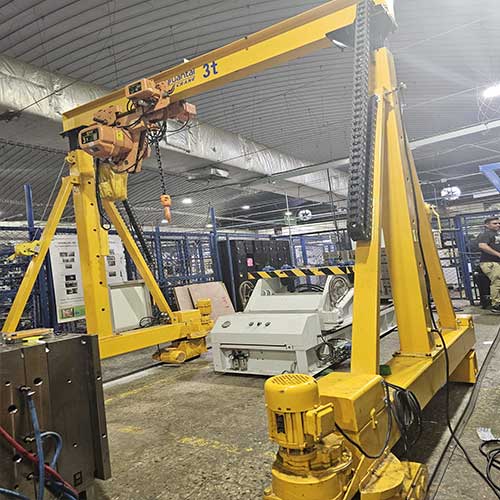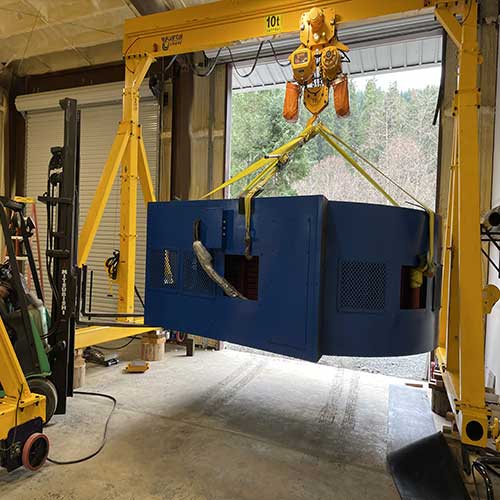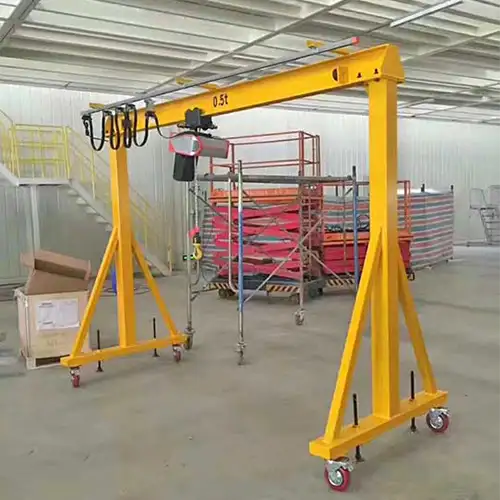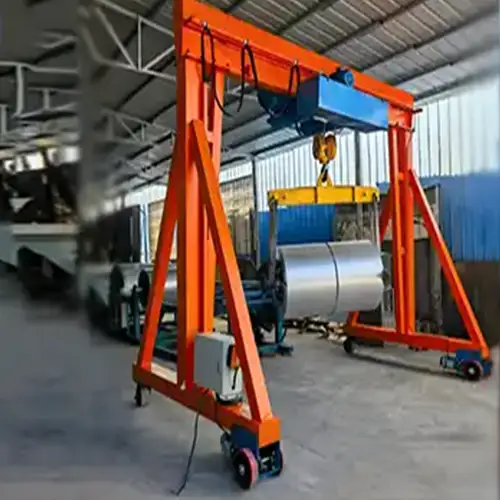How to Choose the Right 1 to 10 Ton Gantry Crane on Wheels
Practical tips to select ideal 1–10 ton portable gantry crane on wheels for efficient lifting in factories or garages.Get garage crane & workshop crane!
Category: Featured
Your Trusted Gantry Crane on Wheels Manufacturer & Supplier
Portable Gantry Crane on Wheels for Lighter Loads Handling
How to Choose the Right 1 to 10 Ton Gantry Crane on Wheels for Your Factory or Garage
Practical tips to select ideal 1–10 ton portable gantry crane on wheels for efficient lifting in factories or garages.Get garage crane & workshop crane!
Introduction
When you need a lifting solution that's mobile, easy to use, and doesn't require permanent installation, a overhead gantry crane on wheels might be just what you're looking for. These cranes are built to move around your workspace—whether that's a factory floor, a welding bay, or even a tight garage—and handle all kinds of day-to-day lifting tasks.
They've become especially popular in small to mid-sized factories, fabrication workshops, and garages, where flexibility and space efficiency are just as important as lifting capacity. The best part? You don't need a heavy investment in infrastructure like rails or a crane runway. You just roll it into place, lift what you need, and roll it away when you're done.
Covers the Most Common Jobs: 1 to 10 Ton Range
Most users don't need a 50-ton monster crane. The 1 to 10 ton capacity range is perfect for handling:
- Equipment maintenance in industrial plants
- Mold changes in injection molding shops
- Material transfers in fabrication workshops
- Engine swaps and mechanical repairs in auto garages
- Small-scale loading and unloading jobs
If you're constantly moving heavy parts but don't have room for an overhead crane system—or you're just not ready to invest in one—this type of gantry crane gives you a lot of lifting power without taking over your space.
Choosing the right gantry crane on wheels isn't just about capacity. You'll need to think about your floor space, the height you need, how often you'll use it, and even how you plan to move it around. In this guide, we'll walk you through everything you should consider so you can find a safe, reliable, and cost-effective lifting solution that works for your specific setup.
Basics of Gantry Cranes on Wheels
What Is a Gantry Crane on Wheels?
A gantry crane on wheels is a type of mobile lifting equipment designed for indoor or outdoor use. It consists of a horizontal beam (called the girder), two vertical support legs, and four or more wheels at the base that allow it to move freely across a flat surface. A hoist—manual, electric, or pneumatic—runs along the beam to lift and move heavy loads.
What sets it apart is its mobility. Unlike fixed gantry cranes or rail-mounted systems, which require a dedicated track or foundation, this crane rolls wherever you need it. No bolting down, no rails, no runway beams.
It's like having an overhead crane you can park wherever it's needed.
How It Differs from Other Gantry Systems:
- Fixed gantry cranes are bolted in place—great for permanent lifting stations but not movable.
- Rail-mounted gantry cranes (RMGs) run on a pre-installed track system—ideal for ports or container yards but overkill for a small shop.
- Wheeled gantry cranes, on the other hand, are plug-and-play. Move them to the load instead of moving the load to the crane.
Benefits of Wheeled Gantry Cranes
Wheeled gantry cranes are often the first choice for shops that need flexibility, especially when lifting tasks change from day to day. Here's why they're such a practical fit:
- Easy to move: Push them manually for lighter capacities or tow them with a forklift for heavier units. No need to call in rigging crews every time you want to reposition your crane.
- No rails or major installation required: Unlike overhead bridge cranes or track systems, these cranes don't require costly building modifications or long install times. Roll it in, adjust it to your space, and get to work.
- Affordable for small to mid-duty tasks: For loads up to 10 tons, wheeled gantry cranes are more affordable than permanent systems. You can get a lot of lifting power without overcommitting your budget.
- Flexible height and span options: Many models offer adjustable height or span, which lets you fine-tune the crane for different spaces or tasks.
Common Use Cases
A wheeled gantry crane is far from a niche tool—it's a solid workhorse for many industries. Here are a few real-world scenarios where they shine:
- Machine maintenance and installation: Roll the crane over a lathe, CNC machine, or compressor to lift parts, swap motors, or do repairs.
- Warehouse and garage material handling: Great for unloading pallets from trucks, lifting heavy tooling, or moving stock around.
- Mold handling in plastic or die-casting shops: Safely and efficiently lift and replace heavy molds during production changeovers.
- Welding and fabrication work: Move steel plates, frames, and structural components in and out of jigs or workstations.
- Heavy equipment assembly: Perfect for workshops that build or service pumps, motors, engines, or gearboxes.
In short, if you've got things to lift, tight space, and limited installation options—a gantry crane on wheels can do the job without overcomplicating your workflow.
Typical Capacity Range: 1 to 10 Ton Gantry Crane on Wheels
When selecting a gantry crane on wheels, one of the first decisions to make is how much lifting power you really need. In most factories, garages, and industrial workshops, the most common and practical options fall within the 1 to 10 ton range. Whether you're doing light tool maintenance or handling large fabricated components, there's a wheeled solution for it. Here's a closer look at each capacity level and what it's best used for.
1–3 Ton Portable Gantry Crane on Wheels: Compact, Light-Duty, and Highly Mobile
If you're working in a garage, small workshop, or doing light-duty tasks, a portable gantry crane on wheels in the 1 to 3 ton range is a smart and practical choice. These units are designed to be easily moved by hand and often come with features like adjustable height, folding frames, and swivel casters with locks for safety.

They're a go-to solution for technicians who need to lift loads without relying on a forklift or permanent crane system.
Ideal for:
- Auto repair shops (engine or transmission handling)
- HVAC equipment installation
- Tool and die maintenance
- Laboratory and light manufacturing setups
Key Features:
- Lightweight frame; often available in aluminum
- Adjustable height to fit under doors or inside vehicles
- Easy to roll and position on flat surfaces
- Minimal setup; can be stored or moved between locations
This size of wheeled gantry crane is about versatility and simplicity—just roll it into place and get to work.
5 Ton Gantry Crane on Wheels: A Practical Medium-Duty Workhorse
The 5 ton gantry crane on wheels offers a strong balance between lifting power and mobility. It's a great fit for operations that involve regular material handling but don't necessarily need a fixed or overhead crane. This capacity is well-suited for medium-duty lifting tasks in maintenance shops, production lines, and mold workshops. Check 5 Ton Aluminum Gantry Crane on Wheels and 5 Ton Steel Portable Gantry Crane on Wheels.
Common Applications:
- Moving molds and dies in injection or casting factories
- Transferring raw materials or machine parts
- Equipment installation and servicing in plant maintenance zones
- Loading/unloading mid-weight parts from trucks
Typical Features:
- Built with a durable steel frame
- Electric hoist or chain block integration
- Manual push or light towing depending on floor conditions
- Adjustable height available on many models
A 5-ton portable gantry crane on wheels is still mobile enough to move around your workspace, but powerful enough to lift more serious loads.

10 Ton Wheeled Gantry Crane: Heavy-Duty Lifting for Industrial Use
When the job calls for strength, a 10 ton wheeled gantry crane is built to deliver. This capacity class is made for heavy industrial settings where loads are large, bulky, and frequent. Due to the size and weight of these systems, they're often towed with a forklift or come with motorized wheel options for easier movement.

Typical Use Cases:
- Fabrication of steel beams or structures
- Engine or equipment handling in repair facilities
- Assembly lines for large mechanical components
- General heavy lifting in mid-sized factories
Key Considerations:
- Heavier steel construction for stability and strength
- Usually equipped with a dual-speed electric wire rope hoist
- Requires clean, flat concrete surfaces for safe movement
- Often customized to match building layout or lifting height
A 10 ton gantry crane on wheels may not be something you push by hand, but it gives you true lifting power without installing a permanent structure.
Capacity at a Glance
| Capacity | Common Name | Best For | Mobility |
|---|---|---|---|
| 1–3 Ton | Portable gantry crane on wheels | Light-duty garage and workshop use | Manual push, adjustable, foldable |
| 5 Ton | Gantry crane on wheels | Medium-duty factory and tool handling | Manual or light towing |
| 10 Ton | Wheeled gantry crane | Heavy-duty lifting in industrial settings | Forklift-towed or powered movement |
Whether you're buying your first portable gantry crane on wheels or upgrading to a wheeled gantry crane for heavier tasks, understanding these typical capacity ranges will help you make the right decision for your workflow and workspace. Check more design drawing of the portable gantry crane on wheels from 1 ton to 10 ton, and if you need customized design please feel free to contact us. WhatsApp; + 86 151 3871 1597.
Key Factors to Consider When Choosing a Gantry Crane on Wheels
Choosing the right gantry crane on wheels involves more than just picking a tonnage. It's about making sure the crane fits your working environment, your daily lifting needs, and even your storage situation when the crane isn't in use. Let's walk through the practical details that really matter.
Load Capacity: Plan for the Real Weight + a Safety Margin
Start with the heaviest load you plan to lift. Then add a 25% safety margin—this is a standard practice to ensure you don't overwork your equipment or put your team at risk.
What to Keep in Mind:
- A 2-ton crane should not be used to lift a 2-ton load regularly—look at 2.5 or 3 tons instead.
- If your load varies, size your crane for the heaviest piece you'll lift, not the average.
- Keep in mind whether the hoist and trolley are included in that total capacity.
Lifting something heavier "just this once" can cost you—play it safe from the start.
Span and Height: Fit the Crane to Your Space
Every workspace is different, and you need your portable gantry crane on wheels to move around without running into walls, doors, or lights. Getting the right span (width between legs) and lifting height is essential.
Things to Check:
- Span: Should be wide enough to straddle your load but narrow enough to fit through doorways if needed.
- Height: Check ceiling clearance and be sure the crane can lift high enough to do the job.
- Adjustable height: Great feature if you work in tight spaces or need to move the crane to different locations.
A crane that's too tall or too wide will be more of a headache than a help.
Mobility Type: Manual Push or Motorized?
Mobility is what makes a wheeled gantry crane so useful—but only if it matches your floor and load conditions.
Choose Based on Your Capacity and Layout:
- Manual push: Ideal for 1–3 ton cranes on smooth concrete floors.
- Towable frame: For 5-ton models and up, use a tugger or forklift to move it.
- Motorized wheels: Optional on heavy-duty cranes for better control and safety.
Also, consider brake systems or wheel locks to prevent drifting during lifts.
Material and Structure: Steel or Aluminum? Modular or Fixed?
The structure of your crane determines how easily it can be moved, assembled, or stored. The choice between steel and aluminum comes down to weight, strength, and how often you'll need to relocate the unit.
Material Options:
- Aluminum: Lightweight, corrosion-resistant, ideal for light-duty portable use.
- Steel: Stronger, more stable for heavier loads, common for 5 ton and 10 ton models.
Structure Options:
- Modular (knock-down): Easier to disassemble and relocate. Great for temporary setups.
- Fixed frame: More rigid and stable but harder to move or store.
If you plan to move the crane between job sites or store it often, go modular. If it stays in one place—go fixed.
Indoor vs Outdoor Use: Environment Matters
Where you use the crane makes a big difference. A portable gantry crane on wheels used outdoors needs to stand up to more than just weight—it has to handle weather, uneven ground, and possible corrosion.
Design for the Environment:
Wheel types:
- Rubber or polyurethane for indoor smooth floors.
- Pneumatic for rough outdoor surfaces.
Corrosion protection:
- Painted steel for indoor, dry conditions.
- Galvanized or stainless options for outdoor, wet, or chemical environments.
Plan for your worst conditions, not your best-case scenario.
Assembly and Storage: How Easy Is It to Move or Pack?
Not every workshop needs a crane up all the time. If you only use your crane occasionally, or you work in multiple locations, ease of setup and storage becomes a big factor.
Consider:
- Foldable or knock-down design: Makes it easy to store in a corner or transport in a truck.
- Bolt-together frame: Easier to disassemble than welded frames.
- Setup time: Some models take 30 minutes, others 3 hours—know what you're getting into.
If space is tight or you're running mobile jobs, portability isn't a bonus—it's a necessity.
Optional Features to Enhance Usability
Once you've nailed down the basics—like load capacity, height, and mobility—there's a whole range of optional features that can make your gantry crane on wheels more convenient, safer, and easier to operate. While not every setup needs all the extras, the right add-ons can improve efficiency and reduce operator fatigue or risk. Here's a look at the most practical features to consider when customizing or upgrading your portable gantry crane on wheels.
Adjustable Height and Span: Fit the Crane to Changing Needs
An adjustable-height or adjustable-span gantry crane gives you the flexibility to work across multiple locations or handle various types of loads.
Why It Matters:
- Lower the beam to fit under a door or roll through a narrow passage.
- Raise the height when working with tall machinery or when lifting parts onto shelves or trucks.
- Some models allow you to adjust span width, which is useful for narrow aisles or different load sizes.
This is especially handy if your workspace isn't fixed or if you're frequently handling different types of equipment.
Motorized Lifting Hoists: Speed and Precision
While manual chain blocks are perfectly fine for light-duty work, a motorized hoist paired with your wheeled gantry crane makes lifting faster, smoother, and much easier on the operator—especially with loads over 2 tons.
Advantages of Motorized Hoists:
- Faster lifting and lowering with better control
- Less physical strain on workers
- Available in single or dual speed for precision
- Can be operated with a wired pendant or remote control
For frequent lifting tasks, investing in an electric hoist pays off in productivity and safety.
Limit Switches and Anti-Drift Features: Stay in Control
Safety is a major concern when operating a mobile crane. Features like limit switches and anti-drift systems help reduce the risk of accidents and equipment damage.
Useful Add-Ons:
- Upper and lower limit switches: Automatically stop the hoist to prevent over-travel.
- Anti-drift guides or wheel locks: Help the crane stay in position during lifting, especially on slightly uneven floors.
- Overload protection: Prevents the crane from lifting loads beyond its rated capacity.
These small additions can help avoid big problems down the line.
Lockable Casters: Mobility with Safety
Casters are what make a gantry crane on wheels truly mobile—but they also need to lock firmly when it's time to lift.
What to Look For:
- 360° swivel casters with foot-activated brakes
- Dual-locking casters that stop both rotation and swivel
- Heavy-duty rubber or polyurethane for indoor use
- Pneumatic tires with chocks or ground locks for outdoor setups
If the crane moves while lifting, it becomes a safety hazard—so make sure the wheels can be trusted.
Electric vs Manual Hoists: Which One's Right for You?
The choice between a manual chain hoist and an electric wire rope or chain hoist depends on your workload, budget, and frequency of use.
Manual Hoists:
- Lower cost, simple to install
- Suitable for occasional lifting or lighter loads
- No power required—ideal for remote areas
Electric Hoists:
- Faster and easier to operate
- Better for daily use and heavier loads
- Requires a power source (usually 220V or 380V)
If you're running multiple lifts daily or handling 5-ton and above loads, an electric hoist isn't a luxury—it's a necessity.
In summary: These optional features aren't just nice to have—they can make your gantry crane on wheels safer, faster, and more versatile. Consider your lifting habits, your team's needs, and your workspace when deciding which extras are worth the investment
Factory vs Garage Applications
Not every gantry crane on wheels is used in the same way. Your working environment—whether it's a full-scale production facility or a compact garage—makes a big difference in the type of crane you should choose. Let's look at how application needs vary between factory settings and garage or workshop use, so you can pick a crane that fits your daily workflow.
Factory Settings: Built for Frequent Use and Heavier Loads
In a factory or industrial production environment, gantry cranes are often used every day, sometimes all day. Lifting isn't occasional—it's a core part of operations. That means the equipment needs to handle higher weights, more cycles, and tougher conditions.
What You'll Likely Need:
- Robust steel gantry frame to support long-term, high-capacity use
- Load capacity of 5 to 10 tons, depending on your materials or machines
- Electric hoist (preferably dual-speed) to boost lifting efficiency
- Motorized wheels or towing brackets to move the crane between work zones
- Anti-sway or brake systems for added safety and load control
Also, factory floors tend to have smoother, wide-open layouts, which makes it easier to use larger, full-span wheeled gantry cranes without space limitations.
Common Applications:
- Mold handling in injection molding lines
- Material transfer between machining stations
- Engine or gearbox lifting in assembly shops
- Large part positioning in welding bays
In short, if the crane is part of your daily production process, it needs to be durable, powerful, and efficient—not just mobile.
Garage or Workshop Use: Light-Duty and Space-Saving
In contrast, garage and small workshop use typically involves occasional lifting tasks—maybe once or twice a week—and much tighter working spaces. Here, portability and compactness matter just as much as lifting ability.
Best Features for Garage Use:
- Lightweight aluminum or compact steel frame
- 1 to 3 ton capacity, enough for engines, tools, or smaller machinery
- Foldable or knock-down design for easy storage
- Manual chain hoist for simple, budget-friendly lifting
- Swivel casters that can lock firmly in tight spaces
In some cases, users need to move the crane through doorways or under ceilings less than 3 meters high, so an adjustable-height frame is a must.
Typical Uses:
- Engine removals and installations
- Moving compressors, welders, or small equipment
- Lifting toolboxes or workbenches
- Occasional material handling
Here, it's not about maximizing lifting cycles—it's about having a safe, flexible tool that helps when the job demands it, without taking up space when it doesn't.
Key Takeaway:
- Factories should invest in durable, high-capacity gantry cranes on wheels with powered features.
- Garages and workshops benefit more from portable, easy-to-store gantry cranes that are light and maneuverable.
Match your crane's design to your actual usage. That's the smartest way to get your money's worth—and ensure safe, smooth operation every time.
Budget and Supplier Considerations
Cost vs. Capability
- The price of a gantry crane on wheels typically increases with lifting capacity, motorization, and structural material.
- For 1–3 ton applications, portable gantry cranes on wheels offer a cost-effective solution with excellent mobility.
- For 5–10 ton needs, expect higher costs due to stronger frames, motorized movement, and safety features.
Local vs. International Suppliers
- Local suppliers may offer quicker support and shipping but limited customization.
- International suppliers, especially in China, often provide better pricing and more flexible designs—ideal for buyers looking for bulk orders or specific specs.
Certifications and Support
Always choose a wheeled gantry crane supplier that offers:
- CE or ISO certifications
- Technical drawings and load calculations
- After-sales support, including spare parts and installation guidance
Summary: Matching the Right Wheeled Gantry Crane to Your Needs
Choosing the right gantry crane on wheels boils down to understanding your lifting requirements and workspace constraints. Here's a recap:
- Capacity Needs: Match your maximum load and add a 25% safety margin.
- Workspace Size: Consider span and height clearance; use adjustable models for flexibility.
- Usage Frequency: Factories with daily lifts need powered units; garages may do fine with a portable gantry crane on wheels.
- Budget: Balance cost with essential features. Don't overpay for unused capacity.
Optional Quick Reference Matrix
| Application Type | Load (tons) | Structure | Mobility | Ideal Choice |
|---|---|---|---|---|
| Light Garage Work | 1–2 | Aluminum | Manual | Portable gantry crane on wheels |
| Workshop Use | 2–5 | Steel | Manual | Adjustable wheeled gantry crane |
| Factory Lifting | 5–10 | Heavy Steel | Motorized | Gantry crane on wheels with powered hoist |
Contact: Find the Right Gantry Crane on Wheels for Your Needs
Ready to choose the ideal portable gantry crane on wheels for your workspace?
Let us help you match the right wheeled gantry crane to your specific needs with a tailored recommendation and quotation.
To get started, prepare the following details:
- Maximum load weight and dimensions
- Available floor space and ceiling height
- Frequency of crane use (daily, weekly, occasional)
- Indoor or outdoor application
- Preference for manual or motorized movement
We offer a full range of gantry cranes on wheels designed for both industrial and light-duty uses.
Related Products

Latest project
Workshop Overhead Crane 5 Ton & 10 Ton Buying Guide
Practical guide for selecting, installing, and maintaining 5 ton to10 ton workshop overhead cranes for safe, efficient, and reliable material handling.
Free consultation to Confirm Parameters & Specifications and Get
Latest Crane Price & Crane Rate.
- Types of overhead cranes : _______?
- Optional: Overhead travelling crane, goliath gantry crane,Slewing jib crane, Single girder or double girder crane,small portable crane or kbk crane, etc.
- Capacity of overhead crane: _______?
- Optional: 0.25ton, 0.5 ton, 1 ton, 2 ton, 3ton, 5 ton, 10 ton,15ton, 20ton, 25 ton, 30ton,35ton, up to 550ton, etc.
- Crane span & lifting height : _______?
- Crane travelling length : _____?
- Control of overhead crane:_______?
- Optional: pendant/ remote/cabin control
- Voltage supply of overhead crane:_____?
- Eg,: 380V50/60HZ,3Phase or others,etc.
- Application/usage of crane:_______?
- Eg,: Steel mill, ,injection mold, cement,stone, concrete,granite, general manufacturing, etc.
Just leave a message via the contact form and our hoist and crane engineer will contact you with in 24working hours.
Get In Touch


